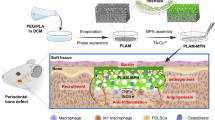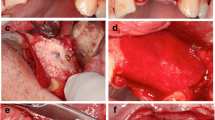Abstract
The technique of guided tissue regeneration (GTR) has evolved over recent years in an attempt to achieve periodontal tissue regeneration by the use of a barrier membrane. However, there are significant limitations in the currently available membranes and overall outcomes may be limited. A degradable composite material was investigated as a potential GTR membrane material. Polylactic acid (PLA) and nanohydroxyapatite (nHA) composite was analysed, its bioactive potential and suitability as a carrier system for growth factors were assessed. The effect of nHA concentrations and the addition of platelet derived growth factor (PDGF) on osteoblast proliferation and differentiation was investigated. The bioactivity was dependent on the nHA concentration in the films, with more apatite deposited on films containing higher nHA content. Osteoblasts proliferated well on samples containing low nHA content and differentiated on films with higher nHA content. The composite films were able to deliver PDGF and cell proliferation increased on samples that were pre-absorbed with the growth factor. nHA–PLA composite films are able to deliver active PDGF. In addition the bioactivity and cell differentiation was higher on films containing more nHA. The use of a nHA–PLA composite material containing a high concentration of nHA may be a useful material for GTR membrane as it will not only act as a barrier, but may also be able to enhance bone regeneration by delivery of biologically active molecules.






Similar content being viewed by others
References
Needleman IG, Worthington HV, Giedrys-Leeper E, Tucker RJ. Guided tissue regeneration for periodontal infra-bony defects. Cochrane Database Syst Rev. 2006; 19(2):CD001724.
Dupoirieux L, Pourquier D, Picot MC, Neves M. Comparative study of three different membranes for guided bone regeneration of rat cranial defects. Int J Oral Maxillofac Surg. 2001;30:58–62.
Bunyaratavej P, Wang H-L. Collagen membranes. A review. J Periodontol. 2001;72:215–29.
Ueyama Y, Ishikawa K, Mano T, Koyama T, Nagatsuka H, Suzuki K, et al. Usefulness as guided bone regeneration membrane of the alginate membrane. Biomaterials. 2002;23:2027–33.
Aurer A, Jorgić-Srdjak K. Membranes for periodontal regeneration. Acta Stomatol Croat. 2005;39:107–12.
Kasaj A, Reichert C, Götz H, Röhrig B, Smeets R, Willershausen B. In vitro evaluation of various bioabsorbable and nonresorbable barrier membranes for guided tissue regeneration. Head Face Med. 2008;4:22.
Cooper ML, Hansbrough JF, Spielvogel RL, Cohen R, Bartel RL, Naughton G. In vivo optimization of a living dermal substitute employing cultured human fibroblasts on a biodegradable polyglycolic acid or polyglactin mesh. Biomaterials. 1991;12:243–8.
Kumar AV, Staffenberg DA, Petronio JA, Wood RJ. Bioabsorbable plates and screws in pediatric craniofacial surgery: a review of 22 cases. J Craniofac Surg. 1997;8:97–9.
Rokkanen P, Bostman O, Vainionpaa S, Vihtonen K, Tormala P, Laiho J, et al. Biodegradable implants in fracture fixation: early results of treatment of fractures of the ankle. Lancet. 1985;1:1422–4.
Domb AJ. Polymeric carriers for regional drug therapy. Mol Med Today. 1995;1:134–9.
Shikinami Y, Okuno M. Bioresorbable devices made of forged composites of hydroxyapatite (HA) particles and poly-lactide (PLLA): Part I. Basic characteristics. Biomaterials. 1999;20:859–77.
Bleach NC, Nazhat SN, Tanner KE, Kellomäki M, Törmälä P. Effect of filler content on mechanical and dynamic mechanical properties of particulate biphasic calcium phosphate polylactide composites. Biomaterials. 2002;23:1579–85.
Cho MI, Lin WL, Genco RJ. Platelet-derived growth factor-modulated guided tissue regenerative therapy. J Periodontol. 1995;66:522–30.
Hughes FJ, Turner W, Belibasakis G, Martuscelli G. Effects of growth factors and cytokines on osteoblast differentiation. Periodontology 2000. 2006;41:48–72.
Giannobile WV. Periodontal tissue engineering by growth factors. Bone. 1996;19:S23–37.
Talal A, Waheed N, Al-Masri M, McKay IJ, Tanner KE, Hughes FJ. Absorption and release of protein from hydroxyapatite–polylactic acid (HA-PLA) membranes. J Dent. 2009;37:820–6.
Wang F, Li M-S, Lu Y-P, Qi Y-X. A simple sol–gel technique for preparing hydroxyapatite nanopowders. Mater Lett. 2005;59:916–9.
Kokubo T, Kushitani H, Sakka S, Kitsugi T, Yamamuro T. Solutions able to reproduce in vivo surface–structure changes in bioactive A–W glass–ceramic. J Biomed Mater Res. 1990;24:721–34.
Koutsopoulos S. Synthesis and characterization of hydroxyapatite crystals. A review study on the analytical methods. J Biomed Mater Res. 2002;62:600–12.
Rehman I, Bonfield W. Characterization of hydroxyapatite and carbonated apatite by photo acoustic FTIR spectroscopy. J Mater Sci Mater Med. 1997;8:1–4.
Matsumoto T, Okazaki M, Inoue M, Yamaguchi S, Kusunose T, Toyonaga T, et al. Hydroxyapatite particles as a controlled release carrier of protein. Biomaterials. 2004;25:3807–12.
Khan AS, Ahmed Z, Edirisinghe MJ, Wong FS, Rehman IU. Preparation and characterization of a novel bioactive restorative composite based on covalently coupled polyurethane–nanohydroxyapatite fibres. Acta Biomater. 2008;4:1275–87.
Teng SH, Lee EJ, Park CS, Choi WY, Shin DS, Kim HE. Bioactive nanocomposite coatings of collagen/hydroxyapatite on titanium substrates. J Mater Sci Mater Med. 2008;19:2453–61.
Kesenci K, Fambri L, Migliaresi C, Piskin E. Preparation and properties of poly(l-lactide)/hydroxyapatite composites. J Biomater Sci Polym Ed. 2000;11:617–32.
Bonfield W, Wang M, Tanner KE. Interfaces in analogue biomaterials. Acta Mater. 1998;46:2509–18.
Pereira MM, Clark AE, Hench LL. Calcium-phosphate formation on sol–gel-derived bioactive glasses in vitro. J Biomed Mater Res. 1994;28:693–8.
Kokubo T. Apatite formation on surfaces of ceramics, metals and polymers in body environment. Acta Mater. 1998;46:2519–27.
Dalby MJ, Di Silvio L, Harper EJ, Bonfield W. In vitro adhesion and biocompatibility of osteoblast-like cells to poly(methylmethacrylate) and poly(ethylmethacrylate) bone cements. J Mater Sci Mater Med. 2002;13:311–4.
Verrier S, Blaker JJ, Maquet V, Hench LL, Boccaccini AR. PLDLA/bioglass composites for soft-tissue and hard-tissue engineering: an in vitro cell biology assessment. Biomaterials. 2004;25:3013–21.
Matsuyama T, Lau KH, Wergedal JE. Monolayer cultures of normal human bone cells contain multiple subpopulations of alkaline phosphatase positive cells. Calcif Tissue Int. 1990;47:276–83.
Stein GS, Lian JB. Molecular mechanisms mediating proliferation/differentiation interrelationships during progressive development of the osteoblast phenotype. Endocr Rev. 1993;14:424–42.
Hott M, Noel B, Bernache-Assolant D, Rey C, Marie PJ. Proliferation and differentiation of human trabecular osteoblastic cells on hydroxyapatite. J Biomed Mater Res. 1997;37:508–16.
Matsumura K, Hyon SH, Nakajima N, Iwata H, Watazu A, Tsutsumi S. Surface modification of poly(ethylene-co-vinyl alcohol). Hydroxyapatite immobilization and control of periodontal ligament cells differentiation. Biomaterials. 2004;25:4817–24.
Zhang Y, Hao L, Savalani MM, Harris RA, Di Silvio L, Tanner KE. In vitro biocompatibility of hydroxyapatite-reinforced polymeric composites manufactured by selective laser sintering. J Biomed Mater Res A. 2009;91(4):1018–27.
Nevins M, Camelo M, Nevins ML, Schenk RK, Lynch SE. Periodontal regeneration in humans using recombinant human platelet-derived growth factor-bb (RHPDGF-BB) and allogenic bone. J Periodontol. 2003;74:1282–92.
Acknowledgments
Authors would like to acknowledge the help provided by Peter Chung at Department of Geographical and Earth Sciences, University of Glasgow in obtaining the SEM images. Drs. I. U. Rehman and A. S. Khan at Department of Materials, Queen Mary University of London for help with FTIR. PURAC Biochem, The Netherlands for providing the PLA.
Conflict of interest
There are no conflicts of interest related to this study.
Author information
Authors and Affiliations
Corresponding author
Rights and permissions
About this article
Cite this article
Talal, A., McKay, I.J., Tanner, K.E. et al. Effects of hydroxyapatite and PDGF concentrations on osteoblast growth in a nanohydroxyapatite-polylactic acid composite for guided tissue regeneration. J Mater Sci: Mater Med 24, 2211–2221 (2013). https://doi.org/10.1007/s10856-013-4963-9
Received:
Accepted:
Published:
Issue Date:
DOI: https://doi.org/10.1007/s10856-013-4963-9




